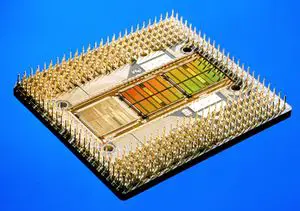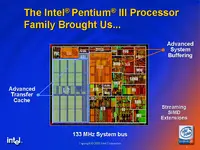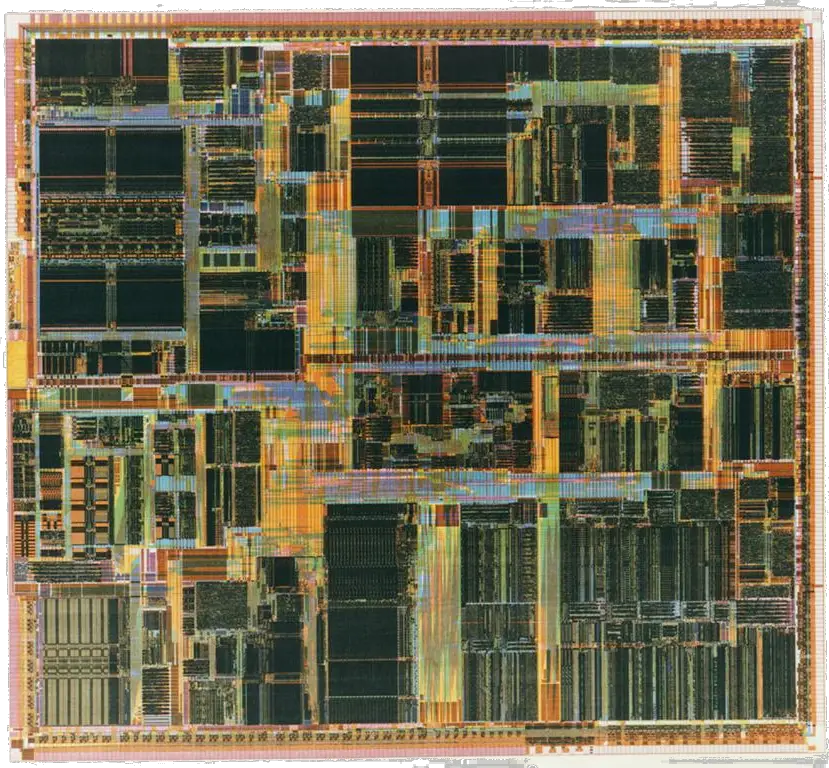From WikiChip
Difference between revisions of "intel/microarchitectures/p6"
| (13 intermediate revisions by 5 users not shown) | |||
| Line 1: | Line 1: | ||
{{intel title|P6|arch}} | {{intel title|P6|arch}} | ||
{{microarchitecture | {{microarchitecture | ||
| − | | | + | | atype = CPU |
| name = P6 | | name = P6 | ||
| designer = Intel | | designer = Intel | ||
| Line 9: | Line 9: | ||
| process = 350 nm | | process = 350 nm | ||
| process 2 = 250 nm | | process 2 = 250 nm | ||
| + | |isa=x86-32 | ||
| succession = Yes | | succession = Yes | ||
| Line 18: | Line 19: | ||
| successor 2 link = intel/microarchitectures/pentium_m | | successor 2 link = intel/microarchitectures/pentium_m | ||
}} | }} | ||
| − | '''P6''' was the [[microarchitecture]] for [[Intel]]'s for desktops and servers as a successor to {{\\|P5}}. Introduced in 1995 and continued until 2000, P6 was fabricated using [[350 nm]] and [[250 nm]] processes. P6 was | + | [[File:pentium pro processor with 1m l2 cache.jpg|right|thumb|{{intel|Pentium Pro}} processor with 1M of [[L2 cache]].]] |
| + | '''P6''' was the [[microarchitecture]] for [[Intel]]'s for desktops and servers as a successor to {{\\|P5}}. Introduced in 1995 and continued until 2000, P6 was fabricated using [[350 nm]] and [[250 nm]] processes. P6 was made obsolete by {{\\|NetBurst}} in late 2000. | ||
| + | |||
| + | == Codenames == | ||
| + | {{empty section}} | ||
| + | |||
| + | == Process Technology == | ||
| + | P6 was manufactured on the [[0.35 µm process]] initially and later enjoyed a process shrink down to [[0.25 µm]], allowing for considerably lower voltage and higher clock speed at a smaller silicon die area. The shrink introduced a 5th metal layer which further reduced RC delay and die area. Intel claimed the channel area was reduced by 50% with the introduction of the 5th layer. The 5th layer also enabled Intel to support C4 packaging. | ||
| + | |||
| + | {| class="wikitable" | ||
| + | |- | ||
| + | ! !! [[0.35 µm]] !! [[0.25 µm]] !! Δ | ||
| + | |- | ||
| + | | Contacted Gate Pitch || 550 nm || 500 nm || 0.91x | ||
| + | |- | ||
| + | | Interconnect Pitch || 880 nm || 640 nm || 0.73x | ||
| + | |} | ||
| + | |||
| + | == Compiler support == | ||
| + | {{empty section}} | ||
| + | |||
| + | == Architecture == | ||
| + | {{empty section}} | ||
| + | |||
| + | == Die Shot == | ||
| + | [[File:p6 tualatin die slide.png|thumb|right|200px|Tualatin]] | ||
| + | === {{intel|Klamath|l=core}} === | ||
| + | * [[280 nm process]] [[CMOS]] | ||
| + | * 4 metal layers | ||
| + | * 7,500,000 transistors | ||
| + | * 13.3 mm x 14.6 mm | ||
| + | * 194.8 mm² die size | ||
| + | * 540-pin BGA (Ball Grid Array) | ||
| + | [[File:intel p6 die shot.png]] | ||
| + | |||
| + | === Pentium Pro === | ||
| + | * [[0.35 µm process]] | ||
| + | * 5,500,000 transistors | ||
| + | [[File:pentium pro die shot.png|700px]] | ||
| + | |||
| + | == References == | ||
| + | * Schutz, J., and R. Wallace. "A 450 MHz IA32 P6 family microprocessor." Solid-State Circuits Conference, 1998. Digest of Technical Papers. 1998 IEEE International. IEEE, 1998. | ||
| + | * Brand, Adam, et al. "Intel’s 0.25 micron, 2.0 volts logic process technology." Intel Technology Journal Q 3 (1998): 1998. | ||
| + | * Integrated Circuit Engineering (ICE) Corporation. "Construction Analysis Intel 266MHz 32-Bit Pentium II (Klamath) Processor"; Shared Construction Analysis (SCA) 9706-542. | ||
| + | |||
| + | == Documents == | ||
| + | * [[:File:24281603.pdf|Intel Architecture Optimization Manual]], Document 242816-003; 1997 | ||
Latest revision as of 21:34, 22 February 2020
| Edit Values | |
| P6 µarch | |
| General Info | |
| Arch Type | CPU |
| Designer | Intel |
| Manufacturer | Intel |
| Introduction | October, 1995 |
| Phase-out | December, 2000 |
| Process | 350 nm, 250 nm |
| Instructions | |
| ISA | x86-32 |
| Succession | |
P6 was the microarchitecture for Intel's for desktops and servers as a successor to P5. Introduced in 1995 and continued until 2000, P6 was fabricated using 350 nm and 250 nm processes. P6 was made obsolete by NetBurst in late 2000.
Contents
[hide]Codenames[edit]
| This section is empty; you can help add the missing info by editing this page. |
Process Technology[edit]
P6 was manufactured on the 0.35 µm process initially and later enjoyed a process shrink down to 0.25 µm, allowing for considerably lower voltage and higher clock speed at a smaller silicon die area. The shrink introduced a 5th metal layer which further reduced RC delay and die area. Intel claimed the channel area was reduced by 50% with the introduction of the 5th layer. The 5th layer also enabled Intel to support C4 packaging.
| 0.35 µm | 0.25 µm | Δ | |
|---|---|---|---|
| Contacted Gate Pitch | 550 nm | 500 nm | 0.91x |
| Interconnect Pitch | 880 nm | 640 nm | 0.73x |
Compiler support[edit]
| This section is empty; you can help add the missing info by editing this page. |
Architecture[edit]
| This section is empty; you can help add the missing info by editing this page. |
Die Shot[edit]
Klamath[edit]
- 280 nm process CMOS
- 4 metal layers
- 7,500,000 transistors
- 13.3 mm x 14.6 mm
- 194.8 mm² die size
- 540-pin BGA (Ball Grid Array)
Pentium Pro[edit]
- 0.35 µm process
- 5,500,000 transistors
References[edit]
- Schutz, J., and R. Wallace. "A 450 MHz IA32 P6 family microprocessor." Solid-State Circuits Conference, 1998. Digest of Technical Papers. 1998 IEEE International. IEEE, 1998.
- Brand, Adam, et al. "Intel’s 0.25 micron, 2.0 volts logic process technology." Intel Technology Journal Q 3 (1998): 1998.
- Integrated Circuit Engineering (ICE) Corporation. "Construction Analysis Intel 266MHz 32-Bit Pentium II (Klamath) Processor"; Shared Construction Analysis (SCA) 9706-542.
Documents[edit]
- Intel Architecture Optimization Manual, Document 242816-003; 1997
Facts about "P6 - Microarchitectures - Intel"
| codename | P6 + |
| designer | Intel + |
| first launched | October 1995 + |
| full page name | intel/microarchitectures/p6 + |
| instance of | microarchitecture + |
| instruction set architecture | x86-32 + |
| manufacturer | Intel + |
| microarchitecture type | CPU + |
| name | P6 + |
| phase-out | December 2000 + |
| process | 350 nm (0.35 μm, 3.5e-4 mm) + and 250 nm (0.25 μm, 2.5e-4 mm) + |



